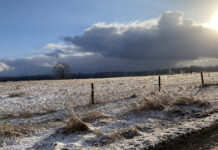On a cold March afternoon in 1983, I sat in a blind on the banks of the Platte River near Kearney, Nebraska, and watched seemingly endless lines of sandhill cranes, Canada geese, snow geese, and many species of ducks descend into the shallows to roost for the night.
The parade continued well past dusk. I could not begin to count them all, but there had to be hundreds of thousands of waterfowl. The scene is as vivid in my mind today as it was at the time.
Huge flocks of birds, the kinds that darken the sky, have inspired awe and wonder for centuries. Ornithologist and artist John James Audubon recalled one incident in which the “air was literally filled with (passenger) Pigeons; the light of noon-day was obscured as by an eclipse…” When such flocks settled in for the night, their collective weight sometimes snapped branches from trees.
Today large flocks of birds still occur, but their size pales in comparison to the numbers of passenger pigeons observed in the 1700s and 1800s. Large flocks help members find food, provide safety in numbers, provide many eyes to detect and avoid predators, and help flock members stay warm on cold winter nights.
Murmuration
To better appreciate the scale and grandeur of large flocks, search online for “nat geo starling murmuration video.” The two-minute clip mesmerizes, and the sound explains why a large flock of starlings is called a “murmuration.”
When alarmed, large flocks of birds take to the sky. They twist and turn almost as superorganisms before landing to resume feeding and/or resting.
Sometimes this even occurs in suburban backyards when hundreds or even thousands of robins or starlings descend to the turf. They forage shoulder to shoulder. At the slightest disturbance, even movement behind a homeowner’s window pane, they burst into flight as one, then quickly return. These observations raise an interesting question: Why do birds live in large groups?
Finding food
Flocks occur for many reasons; they are not random aggregations of birds. Birds, such as starlings in backyards or sandhill cranes in Nebraska, forage more efficiently in larger flocks than they do as individuals. Food often occurs in large, unpredictable, ephemeral patches. Many searchers find food more readily than solitary feeders. Consequently, members of a group typically have faster and easier access to food than individuals.
Safer
Furthermore, living in a large flock is safer than living alone. Though large groups are conspicuous and easy for predators to find, groups are protected by many vigilant eyes and ears. Flock members detect predators at greater distances and flee before real threats materialize. If a hawk or falcon attacks, group members are safer than individuals.
Flocks under attack gather into tight formations and make incredibly precise swoops and turns. This can confuse predators, making it difficult to focus on one individual. Another reason evasive flocks form tight groups is that every individual tries to get to the center of the flock. The center of a group is the safest position because predators usually attack individuals on the edge of a group. A flock member on the edge is easier to separate from the group.
Large roosting flocks enjoy similar advantages. Owls might visit huge nocturnal roosts of crows, but they take only individual birds. So, over the course of a winter a great horned owl might take 100 crows from a large roost. But if there are 50,000 birds in the roost, odds favor survival of flock members. And again, the safest positions in the roost are in the middle, so winter roosts tend to be densely packed. No individuals want to be on the outer edge.
Older, more dominant birds typically take the safest interior spots, leaving younger, less dominant birds to the more vulnerable, peripheral positions. This results in constant bickering and competition for the best positions until all settle in for the night. Another advantage to winter roosts is that flock members can huddle shoulder to shoulder on cold nights to reduce heat loss.
So next time you see a large flock of winter birds, know that there is method to their seeming madness.














One of my favorite poems is “Why I Need The Birds” by the award winning poet Lisel Mueller. It be would definitely worth the space in your columns & enrewsletters. Peace 2022.